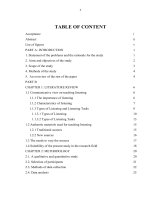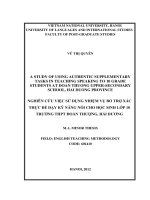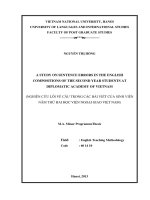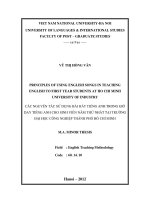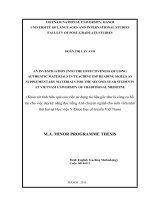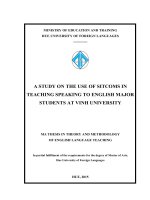Using authentic materials on websites as supplementary materials for teaching listening to 2nd year students at VNU_ULIS.PDF
Bạn đang xem bản rút gọn của tài liệu. Xem và tải ngay bản đầy đủ của tài liệu tại đây (1.72 MB, 79 trang )
5
TABLE OF CONTENT
Acceptance
i
Abstract
ii
List of figures
v
PART A: INTRODUCTION
1
1. Statement of the problems and the rationale for the study
1
2. Aims and objectives of the study
2
3. Scope of the study
3
4. Methods of the study
4
5. An overview of the rest of the paper
4
PART B
CHAPTER 1: LITERATURE REVIEW
6
1.1 Communicative view on teaching listening
6
1.1.1 The importance of listening
6
1.1.2 Characteristics of listening
7
1.1.3 Types of Listening and Listening Tasks
9
1.1.3.1 Types of Listening
10
1.1.3.2 Types of Listening Tasks
13
1.2 Authentic materials used for teaching listening
15
1.2.1 Traditional sources
15
1.2.2 New sources
16
1.3 The needs to vary the sources
17
1.4 Suitability of the present study in the research field
18
CHAPTER 2: METHODOLOGY
20
2.1. A qualitative and quantitative study
20
2.2. Selection of participants
21
2.3. Methods of data collection
22
2.4. Data analysis
25
6
2.5. Limitation of the study
25
CHAPTER 3: DATA PRESENTATION & ANALYSIS
26
3.1 Description of the survey (questionnaire & interview)
26
3.2 Findings analysis
26
3.2.1 Findings
26
3.2.1.1 Findings from questionnaires
26
3.2.1.2 Findings from interviews
41
3.2.2 Interpretations of the findings
46
3.2.2.1 Situation
46
3.2.2.2 Benefits of using online materials
47
3.2.2.3 Ways of using online materials
48
3.2.2.4 Problems
49
CHAPTER 4: USING AUTHENTIC MATERIALS ON WEBSITES AS
SUPPLEMENTARY MATERIALS FOR TEACHING LISTENING SKILLS
TO 2
nd
YEAR STUDENTS.
51
4.1 Ways to exploit online materials for teaching listening skills
51
4.1.1 Working Group Establishment
51
4.1.2 Students’ Support
53
4.1.3 Multi-media Center’s Support
54
4.1.4 Time management
54
4.2 Sample designed listening tasks using online material
55
4.3 Some recommendatory websites
55
4.4 Incorporating online materials into the listening syllabus of the second year
64
PART C: CONCLUSION
71
REFERENCES
73
APPENDICES
I
7
List of Figures
Figure 1: Top-down vs. Bottom-up Listening Process……………………
10
Figure 2: Seniority in teaching listening…………………………………
27
Figure 3: Popular materials in use…………………………………………
28
Figure 4: The use of online materials……………………………………
28
Figure 5: Reasons for not using online sources……………………………
29
Figure 6: Reasons for using online sources………………………………
30
Figure 7: Ways of using online materials………………………………….
31
Figure 8: Prospects of utilizing online materials…………………………
32
Figure 9: Types of speech normally used with online materials…………
33
Figure 10: Problems when using online materials………………………
33
Figure 11: Frequency of online materials using in class…………………
34
Figure 12: Evaluation of students’ progress after using online materials…
35
Figure 13: Supplementary materials in use………………………………
36
Figure 14: The use of online materials…………………………………….
36
Figure 15: Frequency of online materials using…………………………
37
Figure 16: Types of speech normally used with online materials…………
37
Figure 17: Ways of using online materials………………………………
38
Figure 18: Students’ attitude towards the application of online materials
39
Figure 19: Students’ expectation of ways online materials should be used.
40
Figure 20: Students’ self-evaluation of progress after using online
materials…………………………………………………………………
41
Figure 21:
57
Figure 22:
58
Figure 23:
59
Figure 24:
60
Figure 25:
60
Figure 26:
61
8
Figure 27:
62
Figure 28:
63
Figure 29:
64
9
PART A: INTRODUCTION
1. Statement of the problems and the rationale for the study
In the light of the communicative approach for language teaching and
learning, “communicative competence” is a stressed element or in other
words, it is the “goal” of the teaching and learning process (Richards &
Rodgers, 1995: 67). In order to master the communicative competence,
second language learners are supposed to study the four skills, namely
listening, speaking, reading and writing. Among these four skills, listening is
often claimed to be the most important skill to be acquired as “in the foreign
environment, the ability to make sense of these messages is often crucial for
survival” (Hood: 65). As a result, listening has taken much attention and
efforts of language researchers and teachers. Much research has been
conducted on how to teach and learn listening skills effectively. For instance,
on the web site www.abax.co.jp/listen, an article named “Teaching Listening
Better: Is listening being taught as well as it could be?” provides readers with
a thorough overview of how listening should be taught; Penny Ur (1992)
dedicated a nearly-two-hundred-page book on “Teaching Listening
Comprehension” and Gillian Brown (1984) also wrote “Listening to spoken
English”. All these contributions are very useful for enhancing the listening
skills. However, as far as I have investigated, most of the research focuses
largely on methods of teaching and learning rather than exploring new
sources of authentic materials for teachers to make use of.
Meanwhile, nowadays, together with the already diversified published
materials for teaching listening, there co-exists a new abundant source of
listening materials on the World Wide Web. The Internet was given birth not
long ago, in the 1960s, but its presence has changed the world dramatically.
The Internet is said to be the information highway, which host almost every
10
data available. Therefore online resource for teaching listening is no
exception. If we just put into consideration the television and radio programs,
it is a greatly rich source available for every listening teacher to utilize. Let us
count how many English-speaking countries there are in the world, how
many media stations there are in each of those countries and how many
media stations in the non-English speaking countries that offer English
version for their programs there are. Then most of them have their own
websites, on which they upload their broadcast programs with various topics.
These programs are available in many forms convenient for different
categories of Internet users. People can listen to them online or download
them to their computers for later listening. Exploiting this new electronic
source has been a hot topic among the education circle worldwide. Yet in
Vietnam, where Internet was not known until more than 20 years after its
birth, it is still fresh and teachers are hesitant to use it.
Bearing in mind the two aforementioned reasons, I decided to choose “Using
authentic materials on websites as supplementary materials for teaching
listening skills to second year EFL students at VNU-ULIS” the topic of my
thesis with a view to filling in the pointed gap in the research field and
bringing about some benefits for EFL teachers who teach listening skills.
2. Aims and objectives of the study
Conducting this study, my aim is to address two main issues:
(1) How listening skills are taught to second year EFL students at ULIS-
VNU; to be more specific, what materials lecturers are using as
supplementary listening materials for their students.
11
(2) Outline possible prospects to use authentic materials on websites as
supplementary materials to teach listening skills to second year EFL students
at ULIS-VNU.
I do hope that this study will be beneficial not only to lecturers who teach
listening skills for second year EFL students; to the students in their self-
study but also to the students who are becoming teachers in the near future
since it would, hopefully, serve as a useful resource they can refer to.
Conducting this thesis, I also wish that in applying these materials in teaching
listening to the second year EFL students, teachers could familiarize their
students with the current language in use and at the same time help them
enhance their social background knowledge, which is said to be poor among
today students.
3. Scope of the study
Due to time constraint, my thesis would only be narrowed to a small scale.
Firstly, its subject is specifically second year EFL students at ULIS-VNU.
Studying at university for two years would equip students with more self-
study skills, which is a factor that can facilitate the use of online listening
materials. Moreover, it is time their English reach proper level of
intermediate and upper-intermediate, which is suitable to use these materials
to supplement their listening.
Secondly, the paper would focus mostly on ways to develop the use of online
supplementary listening materials for second year students.
I am aware that this study could cover only a small part of the teaching
process if teachers want to use these online materials as supplementary ones
for their students. Therefore, I believe further research is necessary to fulfill
this gap.
12
4. Methods of the study
In order to address the two aforementioned issues, first of all, intensive and
extensive reading helps equip myself with sufficient background knowledge
and also helps obtain data for the literature review.
For the main part of the thesis, both qualitative and quantitative methods are
employed. Questionnaires will be delivered among teachers of the second
year students to investigate the situation of how listening skills are taught and
what materials lecturers are using as supplementary listening materials for
their second year EFL students. The questionnaire is as well used to see
teachers‟ attitude towards using online materials as supplementary listening
materials.
To obtain “rich” data (Burnes, 1999: 23), in-dept interviews will also be
carried out among those teachers who have already used online materials.
The aim is to examine which ways they are dealing with these materials.
In applying triangulation, it is hoped to overcome any shortcomings in either
the quantitative or qualitative methods. Hence, the findings are qualified with
reliability and validity.
5. An overview of the rest of the paper
The paper has three parts. Part A is the introduction to the study. In part B,
chapter 1 reviews the literature on the communicative approach on teaching
listening and the current authentic materials used for teaching listening.
Chapter 2 justifies the use of the qualitative and quantitative methodology for
this research. Chapter 3 presents and discusses the findings of the survey
investigating into how the teachers are exploiting listening materials to teach
their second year students and what their attitude towards using online
sources for listening materials is. Chapter 4 gives some recommendations on
13
how to use authentic materials on websites as supplementary materials for
teaching listening skills to second year students. Part C is the conclusion to
the study.
14
PART B
CHAPTER 1: LITERATURE REVIEW
1.1 Communicative view on teaching listening
1.1.1 The importance of listening
The importance of listening to foreign language teaching and learning has
been reflected in a 30-year shift towards interaction-based acquisition
(Krashen 1981, 1985; Pica et al., 1987; Swain, 1985), rather than learning
through the translation of written text and through formal grammar learning.
Though once regarded as a passive skill, listening is actually an active
process which requires the listeners to activate all their knowledge of
different fields such as phonology, vocabulary, culture and their life
experience and so on in selecting and interpreting information (1983,
Richards; 1995, Rubin, quoted from Duzer, ).
Listening skills are obviously important as first of all, a good speaker needs
to be a good listener. Although listening is described as the most difficult of
the four skills the beginner of a foreign language has to develop (1987,
Eastman quoted in ), it has traditionally been
considered secondary to speaking comprehension (Bower and Cirlio 1985;
Brown and Yule 1983, quoted in ) in that listening
tasks tend to be viewed as supplementary to reinforce grammar learning.
Nunan, a famous linguist, in his featured speech at the 4th Pan-Asian
Conference in Taiwan in November, 2002 remarked that listening is “the
Cinderella skill in second language learning” (o). What
is meant in Nunan‟s comment is shared by Belasco (1965) that listening
comprehension has also been called the "most underestimated and least
understood aspect of foreign language learning" (quoted in
15
). Despite the fact that listening is a critical element
in the competent language performance of second language learners, this skill
has not been taken enough attention of in comparison with other skills such
as speaking, reading and writing. A classic study of listening conducted by
Rankin (1930) suggests that adults spend 42.1% of their communication time
listening, in contrast with 39.1% speaking, 15% reading and 11% for writing.
Moreover, real communication in the classroom should be based on effective
input through listening or reading. According to Lewis, “almost all the
world's natural language output is spoken rather than written” (1993: 32,
quoted in ) therefore listening takes up a
major proportion in communication time as Sam Smith noticed, that is at
least 90% of his interaction time ().
Listening is, in fact, the most crucial medium for input in learning a foreign
language and by increasing students‟ ability to perceive speech and thus
aiding language acquisition (1993, Lewis, quoted in
).
In fact, listening provides a “foundation” for all aspects of “language and
cognitive development” (). It plays a life-long role
in the processes of learning and communication essential to productive
participation in life.
Bearing in mind the importance of listening and the fact that it has been an
underestimated skill, I now move on to review its characteristics.
1.1.2 Characteristics of listening
Most linguists and educators share the same opinion of listening‟s
characteristics. According to Wilkinson, Stratta, Dudley (1974) and
16
Brubridge (1986) and Penny Ur (1996) they all agree upon the common
characteristics of listening as follows:
First to mention, looking at the characteristics of listening is actually looking
at those of spoken language. Spoken language is normally disorganized due
to the fact that it is spontaneous. The speakers talk impulsively rather than
reading aloud some thing written beforehand. As a result, the speech is full of
incomplete sentences, paraphrases, hesitation, repetition and interruptions.
This is also the explanation for the fact that so many students good at
listening task using artificial dialogues are not necessarily good at real-life
listening.
The understanding of spoken language could be facilitated a great deal by
non-verbal clues. It is said that people listen more effectively when they can
see the speaker‟s facial expressions, gestures or even be directly involved in
the environment where the speech is happening. In turn the speakers may rely
on such hints to interpret listeners‟ implication so that they can adapt their
speech accordingly to attain a successful communication. These non-verbal
cues could reveal what the speaker means better than just listening to the
speech alone because both listeners and speakers are put in a certain context.
In real-life listening, listeners often know in advance some information to aid
their understanding such as to whom they are listening, what they are going
to hear and why they are listening. Therefore, listening teachers should
always bear in mind this characteristic so that they can have suitable pre-
listening activities to prepare students for what they are to hear. Penny Ur
additionally thinks that listening is an interactive process. Listeners do not
passively just listen to what the speakers say. They in turn take the alternative
to speak and vice versa for speakers. They actively involve in the
communication because they listen for a purpose.
17
1.1.3 Types of Listening and Listening Tasks
1.1.3.1 Types of Listening
Much as research has pointed out, adults spend almost half of their
communication time listening and for students, the figure mounts up to 90%.
Listening is the most widely used skill though it is also “the least understood
aspect of language of foreign language learning” (Belasco, 1965, quoted from
). There is no fixed set of criteria for different types
of listening. It is categorized from various views.
1.1.3.1.1. Top-down Listening Process vs. Bottom-up Listening Process
Based on the ways listeners process and comprehend what is heard, listening
is said to be composed of two opposite processes, namely top-down and
bottom-up processes (Helgesen, Brown, 1994).
Top-down Listening:
It is listener based. The listener privies to background knowledge of the topic,
the situation or context, the type of text, and the language (Richards, 1990).
This background knowledge activates a set of expectations that help the
listener to interpret what is heard and anticipate what will come next.
According to David Nunan, the top-down view suggests that the listener
actively constructs the original meaning of the speaker using incoming
sounds as clue (o)
Bottom-up Listening
It is text based. The listener relies on the language in the message, that is, the
combination of sounds, words, and grammar that creates meaning (Richards,
1990)
18
Life-
experience
Vocabulary
Structure
Top-down
Bottom-up
Activation
Figure 1: Top-down vs. Bottom-up Listening Process
(Helgesen and Brown, 1994, xii)
The bottom-up processing model assumes that listening is a process of
decoding the sounds that one hears in a linear fashion, from the smallest
meaningful units (phonemes) to complete texts.
The distinction between Top-down and Bottom-up Listening Processes is
visualized vividly by Helgesen and Brown as they employ the metaphor of a
brick wall, “If you are standing at the bottom looking at the wall brick by
brick, you can easily see details. It is difficult, however, to get an overall
view of the wall. And if you come to a missing brick (for e.g., an unknown
word or unfamiliar structure), you are stuck. If, on the other hand, you are
sitting on the top of the wall, you can easily see the landscape. Of course,
because of distance, you‟ll miss some details” (Helgesen and Brown, 1994:
xii)
1.1.3.1.2 Real-life Listening vs. Classroom Listening
19
Additionally, listening can be realized according to the space where it occurs.
To put it most general, listening may be divided into real-life listening and
classroom listening.
Real-life Listening
This is what we have to do in our daily life. We hear music, radio, the noise
and people talking, etc. Sometimes, people just listen without paying much
attention. People may listen and do something else at the same time. This
kind of listening is called Casual Listening (cited in Bang Nguyen, Ngoc
Nguyen, 2002). On the other hand, people listen with a certain purpose in
mind, hence, they really concentrate to get the content of what is said, which
constitutes another type of real-life listening, namely Focused Listening
(cited in Bang Nguyen, Ngoc Nguyen 2002).
Classroom Listening
Penny Ur argues that classroom listening should be addressed accurately as
Real-life listening in the classroom. Though a paradox can be sensed in this
way of addressing, it is not only true that classroom listening is not real-life
listening; but a clear envision of the notion “classroom listening” is also
created. All the listening activities in the classroom aims at equipping
students with skills to deal with real-life listening. Even in classroom
listening, it can be subdivided into intensive and extensive listening as
collected and classified by Bang Nguyen and Ngoc Nguyen (2002).
According to Broughton et al. (1978) extensive listening is concerned with
the more general listening to natural English. It serves the function of letting
the student hear the vocabulary items and structures which are unfamiliar to
him. Rixon (1986) added that extensive listening is listening for pleasure and
interest without having to pay a lot of attention to content and language.
20
Extensive listening keeps the student's motivation and interest high, as well
as gives valuable extra contact with English in its spoken form.
In contrast, intensive listening is much more controlled, with one or two
specific points. Intensive listening can be primarily for language items as part
of the language teaching program or it can be for general comprehension and
understanding (Broughton et al. 1978). Rixon (1986) also stated that intensive
listening is the more widely used form in the classroom. In intensive
listening, students have to collect or organize information. The listening
passages used usually contain more concrete information and may be quite
densely packed.
On Allen‟s stand, listening is categorized as follows (1976):
simple listening - hearing sounds without any particular meaning to the
sounds
discriminative listening - listening to hear and identify the likenesses
and differences in sounds
listening for information,
listening to organize ideas,
listening for main points,
listening for varied points of view,
critical listening
creative listening
Meanwhile, Burns and Lowe (1966) categorized listening into three types:
appreciational (enjoying the development of a story; listening for
pleasing rhythm; reacting to the mood set by the author);
informational listening for the answer to a specific question; listening
to follow directions; following sequence; listening for main ideas);
21
critical (discriminating between fact and opinion; detecting prejudice
and bias; sensing the speaker's purpose.
According to Burns and Lowe (1966) some authors have also suggested
levels of listening such as little conscious listening, half listening, listening
passively, listening and expressing some reaction and listening with a real
meeting of the minds. However Burns and Lowe (1966) pointed out that there
is no research evidence to indicate such levels.
1.1.3.2 Types of Listening Tasks
Having investigated into the characteristics of listening as well as the types of
listening, I now move on to review different listening tasks that reputable
educators have suggested in order to develop students‟ listening skills. These
listening tasks are various. Though sorted respective to the way listening is
viewed from different perspectives, they consist of a rather fixed set of tasks.
As held by Penny Ur, the kinds of listening tasks are classified by the natures
of students‟ response.
No overt response
Students‟ concentration and understanding of the listening are revealed
mostly through their non-verbal language especially their facial expression.
Students actually “do not have to do anything in response to the listening”
(Penny Ur, 1996, 113). The main listening tasks are: story-telling, songs,
entertainment. The only task for students is that they enjoy and understand
the general content of the listening.
Short response
Students are asked to do some tasks in the form of simple and short answers.
For example,
- Obeying Instruction: Students perform actions according to instructions.
22
- Ticking off items: Learners tick beside the items that they hear in the
listening.
- True/False: Identify which statement is either true or false based on the
listening.
- Detecting mistakes: Some fact is mentioned with intentional mistakes for
the students to point out.
- Cloze: Students make a guess of what can be filled in the blanks in the
listening text.
- Guessing definitions: Students listen to a definition and give the answer.
- Skimming and scanning: Learners have to make out some general ideas
(skimming) and details (scanning) of the listening.
Moreover, “multiple choice items” is introduced by Bang Nguyen and Ngoc
Nguyen. To do this task, learners listen to the listening and choose the most
suitable option from the list of option given in advance.
Longer response
- Answering questions: Based on the content of the listening, students are
required to give longer and full answer to questions.
- Note-taking: Students take note of the talk.
- Paraphrasing and translating: students use their own words to rewrite or
retell the listening text either in the same language or in their mother tongue.
- Summarizing: Learners write a summary of the content of what they have
just listened.
- Long gap-filling: Similar to cloze exercise, the only difference is that the
information to be filled in the gap is more.
- Dictation is also a recommended kind of task which can boost learners‟
listening skills a lot as Bang Nguyen and Ngoc Nguyen argue that students
23
must have comprehended what they hear first before they can write it down
(2002).
Extended response
Problem solving and Interpretation are two typical tasks. However, these are
better classified as follow-up listening tasks to integrate the teaching of other
skills.
If listening tasks are built up for students to practice their listening skills by
developing the top-down and bottom-up listening strategies, they can be put
thereby ()
Top-down strategies include:
listening for the main idea
predicting
drawing inferences
summarizing
Bottom-up strategies include:
listening for specific details
recognizing cognates
recognizing word-order patterns
1.2 Authentic materials used for teaching listening
Materials play a very crucial part in the teaching process. According to
Nunan, syllabus is the bone and material is regarded “flesh on the bones of
these specifications” (1991: 208). Richards and Rodgers (1995) add that
instructional materials can provide “specifications of content even in the
absence of a syllabus” (208, quoted from Nunan, 1991). Consequently, a
good set of listening materials and tasks is one of the guarantee factors for the
24
success of teaching. Great effort has long been invested in developing
materials. Hereafters, we will look at different sources for listening materials.
1.2.1 Traditional sources
The most familiar resource that teacher could rely on is published materials.
They are written by experienced textbook writers. Nunan (1991) has pointed
out the reason for teachers to advocate this traditional source of materials is
that they are prepared for the majority to use, hence, intensive research on
learners‟ needs and motivation has been done beforehand. Although the
effective usage of the material for a particular group of students needs further
effort of the teacher to adapt it appropriately because it aims at serving a
general population, teachers find it safe to use these materials as prior to
publication, they have undergone careful piloting. What is more, it lessens the
burden of teachers in designing the listening materials from scratch (Nunan,
1991).
Nevertheless, most textbooks for listening programs emphasize product (right
or wrong answer) over process (how to get meaning) ();
and, as Nunan comments, those materials are “theory-laden” (1991: 214). As
a result, a new form of materials has been taken into consideration.
1.2.2 New sources
In addition to the already well-established sources of listening materials as
mentioned earlier, teachers can take advantage of many other sources such as
movies, songs, TV and radio programs, etc. Moreover, together with the
popularity of the “information highway”, a brand- new source of listening
materials has come into being, that is online materials. This type of materials
is not simply listening tasks that are posted on the Internet. It actually comes
into different shapes and sizes, contributing to the richness of listening pool.
Though using these sources of materials demands greater workload from the
25
teachers, it offers more room for teachers‟ creativity. Yet, this source of
materials has not been utilized to its fullness and little literature has been
spared on the field.
1.3 The needs to vary the sources
The most widely used for listening teachers is uncontroversially course
books. However, any course books will be incapable of catering for the
diversity of needs although users are embarrassed by their riches. Language
teachers need a source that provides them with recordings with which they
can freely tailor the tasks for a particular group of students.
Another reason is that course books are made to be used for a long time;
therefore the language and topics may no longer stay up to date. Meanwhile,
students are more motivated by what is fresh and interesting. As held by Ur,
“motivation makes teaching and learning immeasurably easier and more
pleasant, as well as more productive” (1996), it is time a source that can
enhance students and teachers‟ motivation be found and put into practice.
It is the fact that when using commercially produced materials, it is easy to
run the risk of studying what students have already learnt. Thus, it is
suggestible that teacher-developed materials should be employed as
supplementary task
Students may have access to well-established materials at ease for their own
practice; hence class-hour would be more productive and attracting if learners
are exposed to a unique set of listening materials.
Moreover, as the aim of language learning is communicative competence,
students need to be familiarized with real-life listening which is a huge gap
from simulated ones in listening textbooks, few of which provide
opportunities for “genuine communication with a real purpose” (Nunan,
1991: 214)
26
Last but not least, with the teacher-developed materials, teachers can kill two
birds with one arrow, one of which is that they gain self-development in
doing so.
For all grounds above, it is inevitable for teachers to seek for a satisfactory
source. There raises a question whether such a source exists.
The answer is Internet. Internet, since its birth, has proved to be a useful tool
to store and transfer information. It is a virtual world that can connect people
globally. In education, Internet has also turned out to be an advanced source.
Particularly speaking, in language teaching and learning, Internet has opened
up a totally new way of teaching and learning. Students are provided with
better opportunities to be exposed to native language environment, especially
in listening. Recordings of various topics, various types of speech, various
lengths, are 24 hours available on the information highway. In the following
chapters, we will look at possible ways of using online listening materials to
supplement the official syllabus.
1.4 Suitability of the present study in the research field
As far as I have researched, in the research field of teaching and learning
listening in second language acquisition, the focus is rather theoretical. Most
of the research emphasizes on analyzing the nature of listening and how to
teach this skill, how to help students acquire this skill rather than developing
new materials.
What is more, digital material has been a newly-found source since the
development of the information highway. Therefore, there is still a research
gap on making use of this profuse source.
Furthermore, this research is done specifically based on the specific situation
of teaching and learning at Vietnam National University-University of
27
Languages and International Studies. Hence, it is hoped to be tailor-made for
the teaching and learning in this university.
In brief, with the high practicality of the thesis, it is worth carrying out with a
view to bridging the research gap and assisting teachers in the course of their
teaching.
28
CHAPTER 2: METHODOLOGY
2. 1. A qualitative and quantitative study
This research was conducted as a qualitative and quantitative study, in
which I used interview, information collection and analysis as well as
questionnaire to collect data. The reason for my choice lies in the aims of this
study, in which I would like to answer two questions as follows:
1. What materials are lecturers using as supplementary listening materials
for their students?
2. What are the possible prospects of using authentic materials on
websites as supplementary materials to teach listening skills for second
year EFL students at ULIS-VNU?
As Bouma has stated “both qualitative and quantitative approaches are
essentials to the research process in social sciences” (1996: 173); moreover,
each methodology has its own strengths and weaknesses, thus could not alone
help to find out satisfactory and sufficient information. As a result, I chose to
make full use of both approaches rather than advocate one and dispose the
other so as to achieve the reliable results.
One of the outstanding features of the quantitative methodology is its
objectivity. According to Burnes (1999), the quantitative approach is
employed when the researcher aims at attaining objectivity and control as it is
held that it can “offer ways of testing hypotheses that are widely accepted or
standardised” (1999: 22). Hence, to obtain an overview of the situation how
online listening materials are conceived and used by the teachers, I conducted
a survey among the teaching staff of second year students. Moreover, to have
a comprehensive picture, a similar questionnaire is delivered to the second
year EFL students. In doing so, I would like to cross-check the real situation
29
of listening teaching for second year students and online supplementary
listening material using.
On the other hand, according to Burnes (1999) qualitative research is the
methodology of studying the participants‟ opinion, actions and experiences
through interview, observation and published information. Correspondingly,
this method was made use of in the phase of collecting, analyzing and
synthesizing basic knowledge for the Literature Review for in this part I
needed to have a deep understanding about the setting of the study, the
history of relating studies, ideas, facts and figures.
One strong point of the qualitative method is that the data collected is usually
“extensive” and “detailed” (Burnes, 1999: 23) or as held by Larsen Freeman
& Long, it supplies researchers with “real”, “rich” and “deep” data (1991:12).
For these reasons, I decided to carry out interviews with a few of the listening
teachers for the second year students as I would like to gain profound
understanding of how they view the use of online materials and if they have
already used such materials, in which way they have been using them. Their
insights are of great use for the process of analyzing data.
2.2. Selection of participants
In order to investigate into the situation how listening skills are taught for
second year EFL students and what materials lecturers are using as
supplementary listening materials for their students, I conducted the survey
among two different groups of subjects. The first one is the teachers who
teach second year students. The second one is the second year students. There
are a few reasons for this selection of mine.


